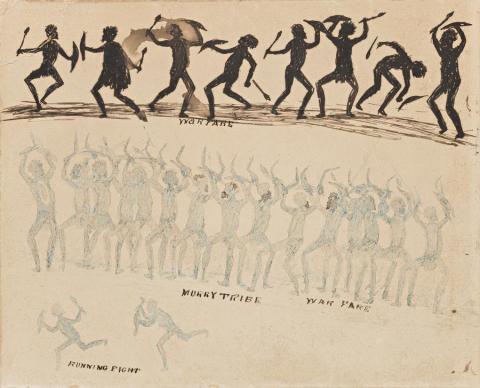MURRAY TRIBE WARFARE, 1890s
TOMMY McRAE
pen and ink on paper
22.0 x 34.0 cm
inscribed throughout composition: WARFARE; MURRY TRIBE WAR FARE; RUNNING FIGHT
Collected in the 1890s by the current owner's great-grandfather, Corowa region, New South Wales
Thence by descent
Private collection, New South Wales
Burton, B., Flow Gently Past: The story of the Corowa District, Corowa, 1973 (illus. opposite p. 52)
Tommy McRae's drawings are of great significance as they offer rare insights into Indigenous culture of the late 1800s. McRae's visual record was a rarity at a time of great change for the local Aboriginal population as the European settlers were progressively colonising the land and resources. McRae depicts traditional scenes of hunting, fishing and ceremony but many works also include depictions of Europeans, Chinese miners and the figure of William Buckley. Some of McRae's most animated and celebrated works are depictions of fights and warfare, an activity which was carried out according to a particular set of understandings.
Warfare between the different groups was a highly ritualised affair with fighting between groups continuing until exhaustion or until a third party, not involved in the skirmish, intervened. As noted by Andrew Sayers, Europeans who witnessed these fights remarked on how the confrontations resembled each other and that these conflicts rarely if ever resulted in death or serious injury.
Murray Tribe Warfare follows a similar formal compositional arrangement to the artist's depictions of ceremonies. Two main rows of figures are drawn across the page from edge to edge, the top row with combatants engaged in the battle and the lower row with a group engaged in a war dance, pre-empting the fight. Boomerangs, shields and clubs are raised above the men's heads. Two figures engaged in a running fight are shown bottom left.
The silhouetted images of the fighters are typical of McRae's economy with the pen yet the gesture and movement in his drawings express all that is necessary to convey the story. As Sayers observes, McRae had a 'keen sense of observation and a characteristic storytelling quality, often showing a wry amusement, combine in his drawings to produce an evocative art, full of vitality'.1
1. Sayers, Andrew, Aboriginal Artists of the Nineteenth Century, Oxford University Press, Melbourne, 1994 p. 49
